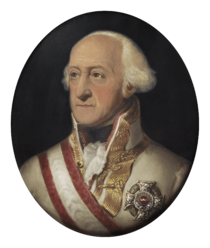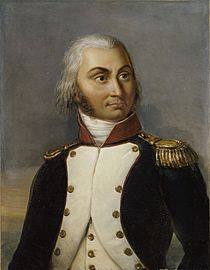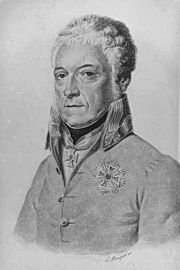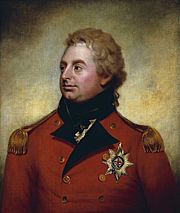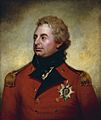Battle of Wattignies facts for kids
Quick facts for kids Battle of Wattignies |
|||||||
|---|---|---|---|---|---|---|---|
| Part of the Flanders campaign in the War of the First Coalition | |||||||
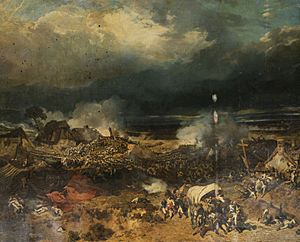 Battle of Wattignies by Eugène Lami |
|||||||
|
|||||||
| Belligerents | |||||||
| Commanders and leaders | |||||||
| Strength | |||||||
| Engaged: 45,000 Jourdan: 45,000 Ferrand: 25,000 |
Engaged: 22,400 Observation Army: 37,000 Siege Army: 26,000 |
||||||
| Casualties and losses | |||||||
| 3,000–5,000 | 3,000 | ||||||
The Battle of Wattignies was an important fight that happened on October 15–16, 1793. It was part of the War of the First Coalition, where France fought against several European countries. A French army, led by General Jean-Baptiste Jourdan, attacked a group of armies from Austria and the Dutch Republic. These armies were under the command of Prince Josias of Saxe-Coburg-Saalfeld.
After two days of intense fighting, Jourdan's French troops won. This victory forced the Austrian forces, led by François Sébastien Charles Joseph de Croix, Count of Clerfayt, to pull back. This allowed the French to end the siege of Maubeuge, a city that had been surrounded by enemy forces. At this time, generals who lost battles often faced very serious consequences. Jourdan also had to deal with Lazare Carnot from the French government, who often interfered with his plans. The village where the battle took place was later renamed Wattignies-la-Victoire to celebrate this important French success. It is about 9 kilometers (5.6 miles) southeast of Maubeuge.
Before the battle, Prince Coburg's main army had surrounded about 25,000 French soldiers inside Maubeuge. About 22,000 Austrian soldiers under Clerfayt were positioned in a semi-circle to protect the fortress from the south. On the first day of the battle, 45,000 French soldiers launched an attack. It was not very well organized and was easily pushed back, except for some fighting near the village of Wattignies. On the second day, Jourdan focused half of his army's strength at Wattignies. After a tough fight, he forced Coburg to admit defeat. Even though the Coalition army was better trained, their units were spread out too much. Also, soldiers from different countries did not work together well. Soon after, the Coalition army stopped fighting for the winter. This ended a military campaign that had started with great hope but finished with disappointment. Lazare Carnot later changed the story to make it seem like he and other politicians deserved most of the credit for the victory. Jourdan was removed from his command in January 1794.
Contents
Why the Battle Happened
In the summer of 1793, a large Coalition army of 118,000 soldiers broke through the line of French forts. They captured Condé on July 12 and Valenciennes on July 27. In the Battle of Caesar's Camp, the Coalition army, led by Prince Coburg, pushed the French Army of the North away from Cambrai on August 7. At this point, the Coalition allies made a mistake by splitting their forces. Prince Frederick, Duke of York and Albany went west towards Dunkirk with 37,000 British, Austrian, Hanoverian, and Hessian soldiers.
From September 6–8, the Army of the North, then led by Jean Nicolas Houchard, defeated the forces covering Dunkirk in the Battle of Hondschoote. This forced the Duke of York to give up the siege of Dunkirk. After this, on September 13, the French won the Battle of Menin. In this battle, they defeated a Dutch army led by Prince William of Orange. The Dutch lost 3,000 soldiers and 40 cannons. Two days later, an Austrian army led by Johann Peter Beaulieu defeated the French and took back Menin.
Coburg's main army finished the siege of Le Quesnoy on September 13, capturing 4,000 French soldiers. Two French groups tried to stop the siege but failed. One group was almost completely destroyed by Coalition cavalry in the Battle of Avesnes-le-Sec. Even though Coburg could have easily taken Cambrai and Bouchain, he decided to move against Maubeuge instead. Because of these defeats, Houchard was arrested on September 23 and put in prison. He was later accused of being a coward and a traitor and was executed on November 16. His predecessor, Adam Philippe, Comte de Custine, had also been executed on August 27, 1793.
Jean-Baptiste Jourdan had been injured at Hondschoote. He was chosen to lead the Army of the Ardennes on September 9. Then, on September 22, he was made the temporary commander of the Army of the North. Jourdan felt he didn't have enough experience to lead such a large army of 104,000 men. However, the government representatives told him that if he refused, he would be arrested. So, the new commander had to respond to the Coalition's move against Maubeuge. Coburg's army began the siege of Maubeuge on September 30.
The Siege of Maubeuge
On September 29, Austrian forces began to surround Maubeuge. Columns of soldiers crossed the Sambre river at different points, pushing the French troops back into the city's defenses. Maubeuge became completely cut off.
Coburg divided his forces into two parts: a 26,000-man Siege Army and an Army of Observation. The Siege Army was led by the Prince of Orange and focused on attacking Maubeuge itself. The Army of Observation, made up of 25,550 infantry and 12,150 cavalry, was positioned to stop any French attempts to rescue the city.
The Coalition began building strong siege works around Maubeuge. The French soldiers inside the city tried to break out but were pushed back. Maubeuge had enough supplies for a normal group of soldiers, but too many were trapped there. By October 10, the soldiers were on half-rations, and many were sick or dying. On October 13, the French had some early success in another breakout attempt. However, their own troops accidentally fired on them, forcing them to retreat. The Coalition then set up powerful cannons and began firing on the town on the night of October 14. This made the soldiers inside feel very discouraged. One of the French leaders, Jean-Baptiste Drouet, tried to escape with some cavalry but was captured.
French Response
Jourdan quickly moved to help Maubeuge. He left 10,000 soldiers to protect other areas and took 20,000 men with him. He also called for 12,000 more soldiers from one camp and 10,000 from farther north. Without waiting for all the reinforcements, Jourdan began to move his army.
Different groups of French soldiers started marching from various locations to join Jourdan. The Committee of Public Safety, a powerful government group, also put the Army of Ardennes under Jourdan's control. Since its commander, Ferrand, was trapped in Maubeuge, a smaller force was gathered to help. Jourdan's army moved east, getting closer to Maubeuge between October 11 and 13.
On October 14, Jourdan and Lazare Carnot, a member of the Committee of Public Safety, checked the Coalition's positions south of Maubeuge. Jourdan's army now had about 44,276 soldiers.
The Battle of Wattignies
First Day: October 15
The Austrian forces were dug in, meaning they had strong defenses. Even though Clerfayt was in charge, Prince Coburg was there and making the decisions. Coburg was so sure he would win that he supposedly said if he lost, he would become a sans-culotte (a term for a radical revolutionary, meaning he would give up his noble status). This story made the French soldiers eager to defeat him.
On the morning of October 15, the Coalition's right side was held by Count Heinrich von Bellegarde with about 5,000 soldiers. The center was defended by Clerfayt with 9,200 soldiers, spread out along a line of villages. Ludwig von Terzi was on the left side at Wattignies with 4,000 men. Farther east, other Coalition forces were positioned.
The French divisions were arranged from right to left. Jourdan had more than twice as many soldiers as the Coalition in this area. The Coalition generals were also worried about the 20,000 French soldiers trapped inside Maubeuge.
On the French right, soldiers attacked near Obrechies but were charged by Austrian cavalry and pushed back, losing three cannons. Another French division attacked Wattignies. They pushed two Austrian groups out of the village, but then a strong counterattack forced them to retreat.
On the far French left, two divisions attacked towards different villages. Austrian cannons opened fire, and a fierce exchange of artillery began. French soldiers fought for control of Saint-Aubin village. In the afternoon, the Austrians counterattacked with regular infantry and cavalry, capturing eight French cannons and forcing the French to flee.
In the center, Clerfayt had strong grenadier (elite infantry) battalions in several villages. Jourdan, Carnot, and another representative were with the central French division. Jourdan wanted to wait for his wings to make progress before attacking the center. However, Carnot insisted on attacking right away. Jourdan bravely led the attack himself. As the French soldiers advanced, they faced heavy fire from the Austrian grenadiers. Despite their efforts, many cannons were destroyed, and soldiers were lost. An Austrian force appeared, threatening the French left side. By nightfall, the French were allowed to retreat after losing between 1,200 and 1,500 soldiers.
Second Day: October 16
During the night, some French soldiers who had left their positions wrongly told the Austrians that Jourdan had been reinforced to 100,000 men. Believing he would be attacked again, Coburg sent five more battalions (about 3,750 men) to strengthen his defenses. The Coalition forces now had about 16,400 infantry and 6,000 cavalry.
Carnot later claimed he convinced Jourdan to attack Wattignies, saying it was the key point. However, others believe Jourdan's plan was typical of his style. Jourdan himself only stated that he ordered the attack on Wattignies. The French divisions on the left and in the center were told to only skirmish, not launch a full attack. Jourdan gathered a special force of about 6,000 men to join the 16,000 soldiers already attacking Wattignies.
On October 16, the French divisions on the left and in the center kept the Austrians busy with small fights. Jourdan launched the main French assault against the high ground of Wattignies with three columns. The attack was also supported by more artillery. When the morning fog lifted, the French cannons began firing heavily on Wattignies. The French columns were pushed back twice by strong fire, but in the early afternoon, they finally forced their way into Wattignies. A counterattack from the northwest briefly pushed the French back, but Jourdan rallied his troops. More French soldiers arrived and defeated the Austrian attack. The French managed to bring a battery of cannons up to the Wattignies heights to support their infantry. Under pressure from the French infantry and artillery, Terzi's Austrian division was forced to retreat.
On the right side of the French attack, another division attacked Obrechies. As the French began to enter the village, the Austrian commander launched attacks from three directions at once, causing the French to flee. They lost five cannons and retreated far back.
Results of the Battle
Jourdan prepared for a long battle and ordered his troops at Wattignies to dig in. The Duke of York arrived with 3,500 men to help Coburg. Coburg had many soldiers, but the Prince of Orange refused to send any of his troops from the north side of the Sambre river to help. Fearing a breakout by the large French force in Maubeuge, Coburg decided to end the siege. He retreated his army across the river. The French commander inside Maubeuge, Chancel, suggested attacking the retreating enemy, but Ferrand decided not to. On October 17, the Maubeuge soldiers marched south to meet Jourdan, instead of pursuing the Coalition forces.
The Coalition reported losing 365 killed, 1,753 wounded, and 369 captured or missing, totaling 2,487 casualties. French losses were estimated at 3,000 to 5,000 soldiers. For the poor performance of the Maubeuge soldiers, Chancel was blamed, arrested, and executed. Another general, Gratien, was arrested but later found innocent. Several famous French officers fought in this battle, including Claude Lecourbe, Édouard Mortier, Jean-Baptiste Bernadotte, and Michel Ney.
What Happened Next
Jourdan did not immediately follow up his victory. After adding the Maubeuge soldiers, he had about 60,000 French troops. However, they faced 65,000 well-defended Coalition troops on the north side of the Sambre river. Even though there was still time for more fighting, Coburg moved his army into winter quarters.
In Paris, Lazare Carnot demanded that Jourdan advance towards Charleroi. Jourdan tried to obey, but he found that the Coalition held all the river crossings, and heavy rain had made the roads impassable. After threatening to resign on November 4, Jourdan was called back to Paris to speak with the Committee of Public Safety. This usually meant arrest and execution, but Jourdan was allowed to return to his army and put his soldiers into winter quarters. After sending 10,000 men to other French armies, time was spent accusing other generals. On January 10, 1794, Jourdan was accused of not protecting the border and called to Paris again. He was strongly defended by Representative Duquesnoy and was only removed from the army, not executed.
Images for kids


